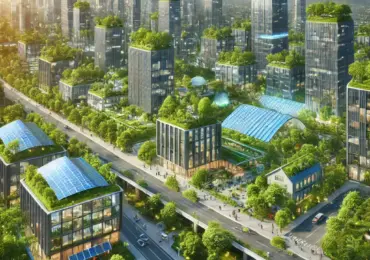Key Takeaways:
- Discover the strategies for sustainable urban development that balance economic growth and environmental preservation.
- Learn how cities worldwide are implementing green initiatives and policies.
- Understand the role of technology and community involvement in fostering sustainable urban environments.

Sustainable urban development promotes economic growth, social cohesion, and environmental protection. With urban populations expected to rise to 68% by 2050, cities must balance expansion and sustainability for long-term prosperity. Strategies that harness innovation, promote inclusivity, and prioritize sustainable resource use are crucial for cities to adapt to current and future challenges.
As urban areas continue to grow, sustainable approaches that secure economic development and environmental stewardship are paramount. Today, cities face the dual challenge of accommodating increasing populations while preserving the natural environments that enhance urban living. For instance, the strategies that Brentwood real estate experts The Milam Group implemented demonstrate how integrating sustainable practices can forge paths toward dynamic yet responsible urban growth. The positive benefits of such strategies are evident in enhanced livability and economic vitality. Given the increasing urbanization trends, understanding these concepts becomes critical for future-proofing our cities.
Sustainable urban development aims to create quality-of-life spaces while minimizing ecological footprints. Cities worldwide face the challenge of expanding infrastructure, housing, and services. This aligns with a global movement to integrate sustainability into urban development strategies, ensuring growth doesn’t harm the planet’s health.
The Role of Green Infrastructure
Green infrastructure is a vital asset in sustainable urban development strategies. Features like parks, green roofs, community gardens, and urban wetlands contribute significant ecological benefits while improving the quality of life in urban settings. These green spaces help manage stormwater, reduce urban heat, enhance air quality, and support biodiversity. Cities such as New York, with its High Line Park, and Singapore, known for its extensive greenery, such as Gardens by the Bay, have invested heavily in green infrastructure, demonstrating its value. These green cities are models of how integrating natural elements within the urban terrain can lead to sustainable and thriving communities.
Importance of Public Transportation Systems
Public transportation systems are crucial for reducing pollution and managing urban growth efficiently. They reduce reliance on personal vehicles, lower congestion, and reduce carbon emissions. Cities like Tokyo and Zurich excel in efficient, extensive, and environmentally conscious systems. Public transportation contributes to economic productivity by reducing travel times and providing equitable access to opportunities across city regions. Studies show that robust public transit options can cut urban carbon dioxide emissions by up to one-fifth.
Renewable Energy in Urban Areas
Urban areas are increasingly adopting renewable energy sources to reduce their carbon footprint. Cities like Copenhagen aim to become carbon-neutral by 2025, using district heating and wind power. Innovations like solar panel installations and small wind turbines can transform buildings into energy producers. These cities demonstrate the potential of urban centers to lead the energy transition and create sustainable futures by embracing renewable solutions.
Community Involvement and Stakeholder Engagement
For sustainable urban development initiatives to be successful, they must actively involve community members and various stakeholders. By engaging people in planning and decision-making, cities can foster a stronger sense of belonging and pride. Tailoring projects to community needs through effective community engagement strategies ensures sustainable and inclusive development. Local governments prioritizing communication and feedback loops achieve better outcomes and more significant support for sustainability projects. Community involvement is essential for realizing the envisioned sustainable urban future.
Challenges and Future Prospects
While strides are being made toward sustainable urban living, several obstacles persist. Financial constraints often limit the scale and speed of projects; policy roadblocks and regulatory hurdles can further impede progress. However, the future holds promising prospects as awareness around climate change grows and technology continues to advance. Smart city technologies, electric vehicles, and digital platforms offer new ways to address complex urban challenges. The cities that will thrive in the future can adapt and innovate, leveraging new technologies and participative governance to overcome obstacles and make urban living more sustainable.
Conclusion
Sustainable urban development offers a practical pathway to balance economic growth with environmental conservation. Urban areas can transform into resilient, livable, and thriving environments by focusing on green infrastructure, advanced public transportation, renewable energy, and community participation. As cities continue to grow and evolve, adopting sustainable practices is wise and necessary to ensure they are equipped to support current and future generations. Understanding and implementing these changes will play a crucial role in shaping tomorrow’s sustainable, vibrant cities.